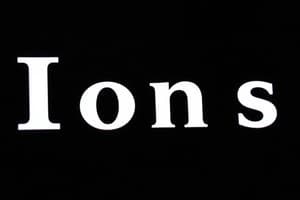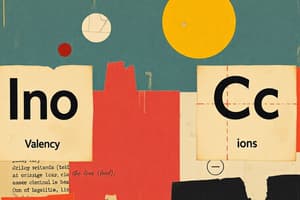Podcast
Questions and Answers
What is the significance of a bracket in a chemical formula when there is only one polyatomic ion?
What is the significance of a bracket in a chemical formula when there is only one polyatomic ion?
The bracket is not required.
How are binary compounds defined?
How are binary compounds defined?
Compounds made up of two different elements.
Explain the process of criss-crossing valencies when writing chemical formulas.
Explain the process of criss-crossing valencies when writing chemical formulas.
Write the constituent elements with their valencies, then crossover the valencies of the combining atoms.
In magnesium chloride, why is the formula written as MgCl2?
In magnesium chloride, why is the formula written as MgCl2?
Why are the charges on the ions not indicated in chemical formulas?
Why are the charges on the ions not indicated in chemical formulas?
What is the chemical formula for aluminium oxide?
What is the chemical formula for aluminium oxide?
Explain why the formula for hydrogen sulphide simplifies to CaO instead of Ca2O2.
Explain why the formula for hydrogen sulphide simplifies to CaO instead of Ca2O2.
Provide the chemical formula for potassium nitrate.
Provide the chemical formula for potassium nitrate.
Write the chemical formula for calcium carbonate.
Write the chemical formula for calcium carbonate.
Explain the term 'chemical formula'.
Explain the term 'chemical formula'.
Flashcards
Binary Compound Definition
Binary Compound Definition
A compound containing two different elements
Criss-crossing Valencies
Criss-crossing Valencies
Switching the valencies of elements when writing chemical formulas
Single Polyatomic Ion Bracket
Single Polyatomic Ion Bracket
Brackets are unnecessary when a formula has only one polyatomic ion
Magnesium Chloride Formula
Magnesium Chloride Formula
Signup and view all the flashcards
Hidden Ions Charges
Hidden Ions Charges
Signup and view all the flashcards
Aluminium Oxide Formula
Aluminium Oxide Formula
Signup and view all the flashcards
Hydrogen Sulphide Simplified Formula
Hydrogen Sulphide Simplified Formula
Signup and view all the flashcards
Potassium Nitrate Formula
Potassium Nitrate Formula
Signup and view all the flashcards
Calcium Carbonate Formula
Calcium Carbonate Formula
Signup and view all the flashcards
Chemical Formula Definition
Chemical Formula Definition
Signup and view all the flashcards
Study Notes
Common Ions and Their Valency
- Common ions include sodium (Na+), potassium (K+), silver (Ag+), copper (Cu+), magnesium (Mg2+), calcium (Ca2+), zinc (Zn2+), iron (Fe2+/Fe3+), and aluminum (Al3+).
- Nonmetallic ions include hydride (H-), chloride (Cl-), bromide (Br-), and iodide (I-).
- Polyatomic ions consist of ammonium (NH4+), hydroxide (OH-), nitrate (NO3-), and hydrogen carbonate (HCO3-).
- Some elements, such as copper and iron, exhibit more than one valency, indicated by Roman numerals (e.g., copper (I) as Cu+ and copper (II) as Cu2+).
Rules for Writing Chemical Formulas
- The charges on ions must be balanced when forming compounds.
- Write the metal name or symbol first followed by the non-metal. Examples include:
- Calcium oxide (CaO)
- Sodium chloride (NaCl)
- Iron sulfide (FeS)
- For polyatomic ions, enclose the ion's formula in brackets and indicate the quantity outside the brackets, e.g., Mg(OH)2 for magnesium hydroxide.
Atomicity and Ratios in Compounds
- Atomicity refers to the number of atoms in a molecule of an element.
- Common compounds and their mass ratios include:
- Water (H2O): 1 part hydrogen to 8 parts oxygen (1:8)
- Ammonia (NH3): 14 parts nitrogen to 3 parts hydrogen (14:3)
- Carbon dioxide (CO2): 3 parts carbon to 8 parts oxygen (3:8)
Ratios by Number of Atoms
- The ratio by number of atoms for water is H:O = 2:1, derived from the atomic masses of hydrogen and oxygen.
Understanding Ions
- Ions are charged species formed from atoms or groups of atoms.
- Ions can be either negatively charged (anions) or positively charged (cations).
- Example: In sodium chloride (NaCl), sodium is a cation and chlorine is an anion.
Studying That Suits You
Use AI to generate personalized quizzes and flashcards to suit your learning preferences.




